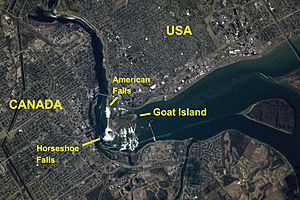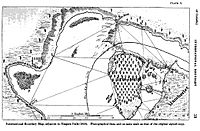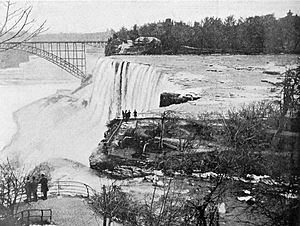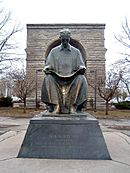Goat Island (New York) facts for kids
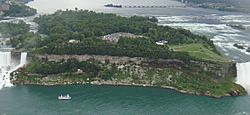
Goat Island
|
|
|
Location of Goat Island in New York State
|
|
| Geography | |
|---|---|
| Location | Niagara River |
| Coordinates | 43°04′51″N 79°04′03″W / 43.08083°N 79.06750°W |
| Highest elevation | 558 ft (170.1 m) |
| Administration | |
|
United States
|
|
| State | New York |
| County | Niagara |
| City | Niagara Falls, New York |
Goat Island is a small island located in the Niagara River. It sits right in the middle of Niagara Falls, separating the Bridal Veil Falls from the Horseshoe Falls. This island is part of Niagara Falls State Park in New York, United States. It is found in the southwest part of the City of Niagara Falls.
Even though no one lives on Goat Island, it is a very popular spot for tourists. Visitors come to see the amazing waterfalls from the U.S. side. The island has many great places to view the falls, like Terrapin Point. You can reach Goat Island from the U.S. mainland by two bridges. These bridges are used by people walking, cars, and even a special trackless train. A pedestrian bridge also connects Goat Island to the smaller Luna Island. Luna Island is right next to the American Falls. Goat Island is mostly covered in trees and has many walking paths. The Cave of the Winds tour elevator lets you go down to the bottom of the falls.
Contents
How Goat Island Was Formed
Goat Island was created as the Niagara Falls slowly moved upstream over time. The Niagara River splits into two channels above the falls. This creates two separate waterfalls, one on each side of the island. In 1959 and 1960, the eastern side of the island was made larger. About 8.5 acres (34,000 m2) of land was added for more parking and a place for helicopters to land. The extra land came from digging for the Robert Moses State Parkway. In 1955, the area between the Terrapin Rocks and Goat Island was filled in. This created Terrapin Point, a popular viewing spot.
In the early 1980s, the United States Army Corps of Engineers added more land. They also built special dams and walls to push water away from Terrapin Point. This work removed about 400 feet (120 m) of the Horseshoe Falls. About 100 feet (30 m) of this was on the Canadian side. Some people say that the Horseshoe Falls is now completely in Canada. Others say that "most of" it is in Canada.
The western end of Goat Island is slowly being worn away by the powerful waterfalls. Over a very long time, the entire island will disappear as the falls continue to move upstream. The water around Goat Island is not very deep. It has many small islands and rocks. Many exciting rescues have happened in these waters.
History of Goat Island
The island got its name from an early pioneer named John Stedman. He was a miller who kept a group of goats on the island. After a very harsh winter in 1780, he returned to the island. He found that all but one of his goats had died. This sad event gave the island its current name.
Goat Island was saved as a park thanks to Augustus Porter. In the mid-1800s, he realized how important the falls would be for tourists in the future. Porter bought the island and allowed a group of Tuscarora Native Americans to live there. They sold their crafts to visitors who came by stagecoach and early railroads. Even though there was pressure to change the island, Porter kept its natural environment. In 1817, he built a toll bridge to the island for tourists. Ice swept it away, so another bridge was built the next year. This new bridge was almost seven hundred feet long. It quickly became the most used walkway in the area.
In 1885, Goat Island became part of the Niagara Falls State Park. This park is the oldest state park in the United States.
Tesla Monument on the Island
Goat Island is home to a special monument that honors Nikola Tesla. He was a famous Serbian-American inventor. The government of Yugoslavia gave this statue to the United States in 1976. The statue was created by Frano Kršinić, a well-known sculptor from Yugoslavia. In 2016, the statue was moved to Stedman's Bluff. This part of the island overlooks the Bridal Veil Falls and the American Falls. The move was made to help more people see the monument.
Plant Life on Goat Island
In 1879, a landscape architect named Frederick Law Olmsted visited the island. He wrote that he had traveled thousands of miles across the continent. He said he had not found the same beautiful forest quality anywhere else. This beauty was once common around the falls. He noted it could still be seen in parts of Goat Island where the original trees and shrubs had not been disturbed. Olmsted believed that the spray from the Falls created a natural home for local plants. Since that time, regular mowing, heavy foot traffic, and the arrival of invasive species have changed the island's plant life a lot.
Images for kids
See also
 In Spanish: Isla de la Cabra para niños
In Spanish: Isla de la Cabra para niños



